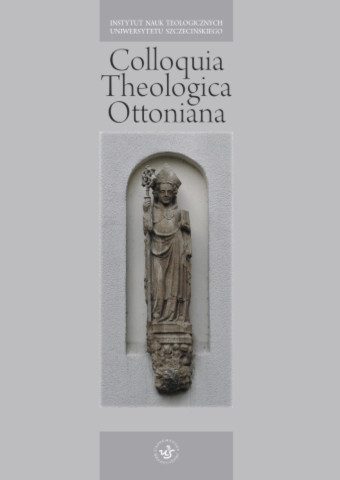
ISSN: 1731-0555
eISSN: 2353-2998
OAI
DOI: 10.18276/cto.2020.36-03





Issue archive /
36/2020
Czy istnieje dostosowana liturgia misyjna? Spór o komunikatywność liturgii
(AN ADAPTED MISSIONARY LITURGY? DISPUTE OVER COMMUNICATIVENESS OF LITURGY)
| Authors: |
Andrzej
Draguła

Uniwersytet Szczeciński |
| Keywords: | liturgy religious communication mystagogy religious initiation |
| Data publikacji całości: | 2020-12-20 |
| Page range: | 20 (67-86) |
Abstract
One of the main directions of the renewal initiated by the Second Vatican Council was the adaptation (aptactio, accomodatio) of the liturgy to changing cultural conditions and cognitive abilities of the faithful (fidelium captus). The Council recognised that the established historical form of the liturgy ceased to correspond to the mentality of its times; hence, the demand for a more comprehensible liturgy and thus a more attractive one – so that it would draw more participants. This postulate is combined with the conviction that the liturgy should fulfil an evangelising function, which makes the didactic dimension dominant over the mystery proper to the liturgy. The paper criticises that postulate. A liturgy that has missionary or evangelising potential does not need to succumb to a didactic strategy. The most missionary liturgy may be a seemingly incomprehensible liturgy, but one that gives the opportunity to experience and live the ritual, i.e. initiation and mystagogical liturgy. This view stems from the assumption that a liturgy’s communicativeness goes beyond a narrowly understood intellectual intelligibility. Is this reserved solely – as some claim – to the liturgy celebrated in the extraordinary form of the rite, which is supported by the mystery of Latin and increasingly hermetic sign system? The author argues that also the so-called post-conciliar liturgy has mystagogical potential, and the focus on the didactic dimension leads to a deformation of the nature of the liturgy, as its fundamental dimension is performativity and not intelligibility.
Download file
Article file
Bibliography
| 1. | [b.a.], Misyjne powołanie Centrum św. Pawła w Paryżu, http://www.nowyruchliturgiczny.pl/2012/07/misyjne-powoanie-centrum-sw-pawa-w.html (dostęp: 25.04.2020). |
| 2. | Corbon J., Liturgia. Źródło wody życia, tłum. A. Foltańska, Poznań 2005. |
| 3. | Dekert T., Inicjacja czy dydaktyka? „Msza z udziałem dzieci” a społeczna funkcja rytuału, w: Polska kultura religijna. Studia o polskiej religijności na przestrzeni wieków, red. Ł. Burkiewicz i in., Kraków 2019, s. 545–565. |
| 4. | Kołakowski L., Jezus ośmieszony. Esej apologetyczny i sceptyczny, tłum. D. Zańko, Kraków 2014. |
| 5. | Kongregacja ds. Kultu Bożego i Dyscypliny Sakramentów, Dyrektorium o pobożności ludowej i liturgii. Zasady i wskazania, Poznań 2003. |
| 6. | Mazza M., [hasło:] Mistagogia, w: Dizionario di omiletica, red. M. Sodi, A.M. Triacca, Torino–Bergamo 1998, s. 972–973. |
| 7. | Miazek J., Posoborowa odnowa liturgii w Polsce, „Studia Theologica Varsaviensia” (1987) 2, s. 238–252. |
| 8. | Nadolski B., [hasło:] Lex orandi, lex credendi, w: B. Nadolski, Leksykon liturgii, Poznań 2006, s. 735–737. |
| 9. | Nadolski B., [hasło:] Mistagogia, w: B. Nadolski, Leksykon liturgii, Poznań 2006, s. 944. |
| 10. | Nadrowski H., Kościoły naszych czasów. Dziedzictwo i perspektywy, Kraków 2000. |
| 11. | Ratzinger J., Kościół. Pielgrzymująca wspólnota wiary, tłum. W. Szymona, Kraków 2005. |
| 12. | Ratzinger J., Nowa pieśń dla Pana. Wiara w Chrystusa a liturgia dzisiaj, tłum. J. Zychowicz, Kraków 1999. |
| 13. | Robaczewski A., „Tradsi” a Nowa Ewangelizacja, http://rebelya.pl/post/2689/robaczewski--tradsi-a-nowa-ewangelizacja (dostęp: 25.04.2020). |
| 14. | Sałatka T., Porządek i wolność liturgii w popkulturze, „Studia Paradyskie” (2015) 25, s. 181–200. |
| 15. | Schenk W., Liturgika – liturgia – kult, w: Wprowadzenie do liturgii, pr. zb., Poznań–Warszawa–Lublin 1967, s. 9–18. |
| 16. | Słownik języka polskiego PWN, http://sjp.pwn.pl/sjp/dostosowac-sie;2453700.html. |
| 17. | Według Boga czy według świata? O stanie liturgii i wiary z Pawłem Milcarkiem rozmawiają Jacek Paweł Laskowski i Bogusław Kiernicki, Dębogóra 2011. |
| 18. | Wollbold A., Mystagogie (systematisch-theologisch), w: Das Lexikon für Theologie und Kirche, Bd. 7, Freiburg–Basel–Rom–Wien 1998, kol. 570–571. |
| 19. | Zachara M., Znak i słowo w liturgii, „Znak” (2000) 11, s. 34–48. |
| 20. | Zdunkiewicz-Jedynak D., Komunikatywność kaznodziejska. Z obawy przed kościelnym gadaniem, „Poradnik Językowy” (2010) 10, s. 35–45. |